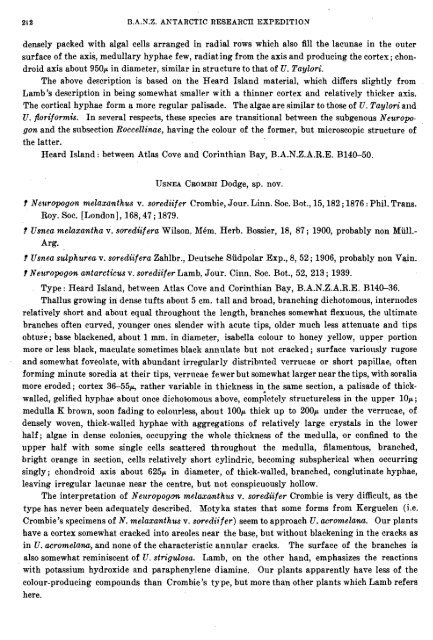You also want an ePaper? Increase the reach of your titles
YUMPU automatically turns print PDFs into web optimized ePapers that Google loves.
21 2<br />
B.A.N.Z. ANTARCTIC RESEAliCII EXPEDITION<br />
densely packed with algal cells arranged in radial rows which also fill the lacunae in the outer<br />
surface of the axis, medullary hyphae few, radiating from the axis and producing the cortex ; chondroid<br />
axis about 950,~ in diameter, similar in structure to that of C. Taylori.<br />
The ahove description is based on the Heard Island material, which differs slightly from<br />
Lamb's description in being somewhat smaller with a thinner cortex and relatively thicker axis.<br />
The cortical hyphae form a more regular palisade. The algae are similar to those of U. Taylori and<br />
U. floriformis. In several respects, these species are transitional between the subgenous Neuropogon<br />
and the subsection Roccellinae, having the colour of the former, but microscopic structure of<br />
the latter.<br />
Heard Island : between Atlas Cove and Corinthian Ray, B.A.N.Z.A.R.E. B140-50.<br />
TJSNEA CROMBII Dodge, sp. nov.<br />
? Nez~rqwgon melaxuunlthus v. sorediifer Crombie, Jour. Linn. Soc. 13ot., 15,182 ; 1876 : Phil. Trans.<br />
Roy. Soc. [London], 168,47 ; 1879.<br />
? Usnea melaxantha v. swediifera Wilson. B44m. Herb. Bossier, 18, 87; 1900, probably non Miill.-<br />
Arg.<br />
? ITsnea sdphurea v. soredifera Zahlbr., Deutsche Siidpolar Exp., 8,52; 1906, probably non Vain.<br />
f Neitropogon antarcticus v. sorediifer Lamb. Jour. Cinn. Soc. Rot., 52, 213 ; 1939.<br />
Type: Heard Island, between Atlas Cove and Corinthian Ray, B.A.N.Z.A.R.E. R140-36.<br />
Thallus growing in dense tufts about 5 cm. tall and broad, branching dichotomous, interiiodcs<br />
relatively short and about equal throughout the length, branches somewhat flexuous, the ultimate<br />
branches often carved, younger ones slender with acute tips, older much less attenuate and tips<br />
obtnee; base blackened, about 1 mm. in diameter, isabella colour to honey yellow, upper portion<br />
more or less black, maculate sometimes black annulate but not cracked; surface variously rugose<br />
and somewhat foveolate, with abundant irregularly distribnted verrucae or short papillae, often<br />
forming minute soredia at their tips, verrucae fewer but somewhat larger near the tips, with soralia<br />
more eroded; cortex 36-55p, rather variable in thickness in the same section, a palisade of thick-<br />
walled, gelified hyphae about once dichotamous above, completely structureless in the upper lop;<br />
medulla K brown, soon fading to colourless, about 100p thick up to 200p under the verrucae, of<br />
densely woven, thick-walled hyphae with aggregations of relatively large crystals in the lower<br />
half; algae in dense colonies, occupying the whole thickness of the medulla, or confined to the<br />
upper half with some single cells scattered throughout the medulla, filamentous, branched,<br />
bright orange in section, cells relatively short cylindric, becoming subspherical when occurring<br />
singly; chondroid axis about 625p in diameter, of thick-walled, branched, conglutinate hyphae,<br />
leaving irregular lacunae near the centre, but not conspicuously hollow.<br />
The interpretation of Neuropogm melaxmthzu v. sorediifer Crombie is very difficult, as the<br />
type has never beell adequately described. Votyka states that some forms from Kerguelen (i.e.<br />
Crombie's specimens of N. melaxanthus v. sorediifer) seem to approach U. mromelam4. Our plants<br />
have rt cortex somewhat cracked into areoles near the base, but without blackening in the cracks as<br />
in U. acromelam, and none of the characteristic annular cracks. The surface of the branches is<br />
also somewhat reminiscent of U. strigdosa. Lamb, on the other hand, emphasizes the reactions<br />
with potassium hydroxide and paraphenylene diamine. Our plants apparently have less of the<br />
colour-producing compounds than Crombie's type, but more than other plants which Lamb refers<br />
here.

















